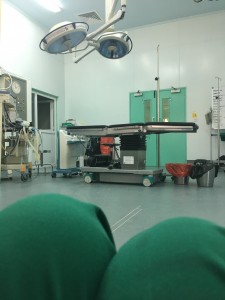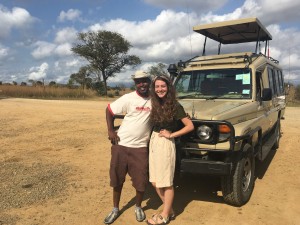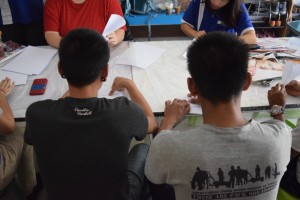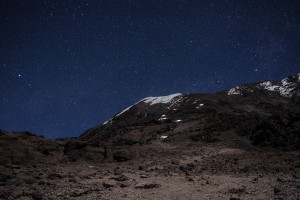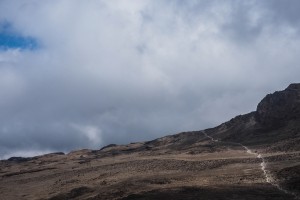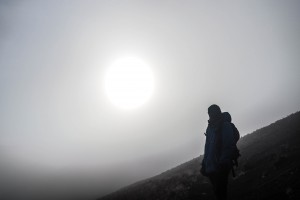The Safari Journey
On the Way to Safari
25/08/2017
I literally can not contain my excitement to be going on the safari! Today is finally the day! My favorite animal in the entire world is an elephant or in Swahili tembo.

Two female elephants and one of their babies
I’m going to actually be able to see them in their natural habitat and home! It’s a 7 to 8 hour drive to the national park! Therefore, I have a lot of time to just think and write about everything I’m feeling. I’m really happy I’m able to get out of Dar and see the more rural area of Tanzania. Though a lot of people live in Dar (which is a huge city and Capitol of Tanzania) a lot more live outside of the city and the rural areas are more representative with how the majority of people live in Africa. The last 2 hours I’ve just been mesmerized with simply staring out the window and observing my surroundings away from Dar. It took forever to get out due to so much traffic. It’s so different to see so many people take local transportation to get to work. There are so many bus options you can take. There’s this thing in the city (the name of it isn’t coming to mind) which is where people get on the bus and there’s no traffic. There’s a lane made just for that bus in between the two main car lanes on the road and it never has to sit in traffic. There’s a specific lane just for those buses (kind of like a subway). Just like the dala dala the people were PACKED on it. The people on the buses here literally looks like sardines in a can. All you see is a big blob of people because everyone is squished together. I love taking the buses because that’s how the people here travel and you feel more like a local. I like to call the dala dala bus rides dala dala yoga. This is the main transportation I take every day to and from the hospital. You just never know which body part is going to be stretched.
Here is a link that discusses what the bus system is like: http://www.eastafricatravelguide.com/tanzania/get-around.html
When you look out and see the shops/road side stands and homes it can be kind of hard to take in. Imagine a big, black metal pot of boiling water over a fire where a beautiful mom dressed in a colorful, bright dress and kanga is cooking food over. Right beside her are 10 people both standing and sitting eating food and conversing. There’s dirt and trash all around them. Behind them you see a row of run down shops which kind of look like mini road side stands/markets where people are selling various goods like oranges, corn on the cob, nuts, etc. All around them are people commuting to work. They’re either waiting for bus’ or waiting to cross the road. Right behind the road side stands and all the people commuting and cooking you see these little shanty shacks/homes. They are all piled together. Some are completely closed in but others you can see where there’s an opening.
Something that’s really been on my mind lately is how can I accurately convey what I see? No matter how many photos I take or how much I describe what I see it’s just not the same and can’t do it justice. You just have to experience it for yourself in order to truly understand the experience. This makes me so sad because I know a lot of people in my life who will probably never come to Africa. It’s so sad because Africa teaches you SO much and exposes you to a new way of seeing life. The people here are unlike any other people I have ever met. Knowing that some people will go their entire lives without seeing this side of the world is heartbreaking. We can learn so much from one another. How can I bring this world and life to my other world and life in America? How can I help further Africa develop as far as healthcare and educating people goes?
As you progressively get more and more out of the city you begin to go through villages. There are hardly any shops. You see Maasai herding cow and oxon. It was so eye opening to be able to see this side of Tanzania rather than just the city. It makes me quite sad because most people who have recently been born and live in Dar weren’t brought up by a tribe. Since Dar is the biggest city in East Africa it has a lot of Western influence. Therefore, the younger generation that live their tend to lose some of the ways of their people. That’s apart of Africa that makes the culture so rich. I am saddened when I see a lot of western influence here. Rather than a woman wearing a bright colored, long dress you may find her in a pair of jeans. So plain and stereotypical of where I am from. The majority of people I have met in Dar seem to have an admiration for how we do things in the western region. They try to mimic how we dress, act, and do things. To an extent, it is a good thing.
There are some great things that they can learn from our infrastructure and mold into their own social infrastructure as they see fit. The main two I think they could learn from is taking a look at our foundations that could help the growth of their economic capital and social justice. On my connecting flight from Istanbul to Tanzania I met two gentleman who worked for the Tanzanian Constitution Forum. I have been able to be in contact with them throughout my journey so far. They travel all over the world in hopes to learn from other countries and change their constitution so that they can help their country grow to its fullest. They do a lot of civic education and public engagements to educate people in Tanzania to take a stand and fight the government to implement and reform their constitution. This is an amazing thing to be apart of and I was so blessed and humble to talk with them for hours in the airport waiting for our flight. However, I just don’t want the people of Africa to ever lose their heritage and culture. Being able to travel somewhere different than what I am use to seeing is like finding a gold gem in a cave of brown granite. Every place is unique and beautiful in the world. We can definitely learn from one another but we must remember to hold onto what makes us, us.
Now back to transportation. A lot of my nursing friends explained to me that buses are their way of transportation to get home (the ones that weren’t born in Dar). It’s the cheapest form of transportation. Although it would be quicker to fly it’s best on the wallet to take the bus. The bus is not air conditioned and it probably fits about 60 people on it. There are so many different kinds of buses that people take depending on which region they’re going to. Mikumi National Park is in the Morogoro region. Bear is in the south and that’s a 14 hour bus ride. But the bus is the most common mode of transportation I would have to say.
As I’m staring out my window and seeing everything of course the wheels in my head start spinning. I keep thinking of everything from a health perspective. What type of healthcare and treatment do the people in rural areas have? How close is the nearest hospital and what are their resources like? Muhimbili National Hospital in Dar is a government run, regional hospital. So the most severe and sickest people are typically seen here. People in the rural areas who can’t get the resources they need in their region are sent to Dar to get treatment. However, they have to take the bus because that’s all they can afford. Imagine if you’re severely sick and you need treatment as soon as possible but you have to get on a bus that could take 8, 14, 16 hours. I honestly can not even fathom that. That’s so scary to think of. There were so many accidents we passed by where big semi trucks were in ditches and completely flipped over. I just kept wondering if the people survived those accidents. It’s so heartbreaking to come to the realization that so many people simply die due to lack of resources and poverty. If you can’t pay for treatment then you simply don’t get treated. Moreover, we would pass by SOO many people riding motorcycles extremely fast without helmets. At one time I saw three gentleman riding a motorcycle with no helmet on. They were all in flip flops and t-shirts around my age maybe a bit older. They would just weave in and out of the lanes. Overtaking is such a big thing here and everyone does it continuously. When we went to the village and were actually on one of the buses I honestly couldn’t tell you how many times I saw the bus overtake cars when there was a car coming in the next lane. Maybe 20 times at least?
In addition, this was the first time I’ve seen actual speed limits and police pulling people over. They even pulled over our safari vehicle once for overtaking someone. When I asked our safari guide, Rama, why is that In Dar there’s no speed limits or anything he explained that since Dar has so much traffic there’s no need to have speed limits whereas compared to the rural areas you could easily go 100 because there’s hardly any congestion once you’re out of the city. Rama taught us a lot. He explained in habitation areas the speed limit is always 50 kilometers per hour. These are areas like schools, zebra crossings, etc. However, once you’re out of those zones you’re allowed to go up to 80. However, when we were on the bus going to the village I caught the bus going 120.
Overall, I would absolutely love to do research to see the percentage of health habits as in smoking, food intake, and so on. In addition, to studying infectious diseases and how the government of Tanzania can have certain grants that go towards vaccinations as well as pass legislation that will help hone in on these problems. How can I be apart of that? Sometimes I feel like a little green pea just sitting at the bottom of the Indian Ocean. How can I be apart of helping their health system? Where do I even begin?
Mikumi National Park Part 2: Safari and Maasai
26/08/17

My safari rafikis!
This weekend was an absolute dream come true. We got to see every kind of animal you could imagine: elephants, giraffes, lions/lioness, zebras, baboons, pumas, etc.

Antelope are known as the McDonald’s of the savannah because there are so easily eaten as prey because of how many there are. Do you see the “M” on their back end near their bottom?

There were literally everywhere!

Such big antlers

Mommy and baby baboon!

One of my new favorite animals. They are so smart. We got the chance to feed them fruit before we got into the park.

A class that took a field trip to the park!

There’s a highway that runs right through the national park! Semi trucks go SO fast on it. We got the chance to see some giraffe’s crossing. This is so common to the local people. It is like seeing a deer for us crossing the road. I was constantly in awe!



Even rare ones that I never even dreamed of living like the colored plum thrush or the lilac breasted rola which is a type of starling.


It took everything I had in me to not leap out of the safari jeep and hug the elephants.
Some of the quick fun facts that I learned: 6% of a giraffes body weight is made up of their heart because their heart has to pump so much blood all the way up to the head and down to their legs. Giraffes also just have seven vertebras. Giraffes live to be up to 30-35 years old. Elephants spend about 16 hours a day on feeding and consume around 250 kilos a day. Rama then went on to explain how elephant poop is actually used for quite a bit of things. Their poop can treat epilepsy and is also used as insect repellent. He also said that some people even smoke elephant poop. Rama would also tell us all of the different legends and stories of some of the animals and trees. One of my favorite stories was the story of the baobab tree. This tree is literally upside down! I’ve attached an article that tells all about it because it is just so fascinating!
http://nature-explored.com/baobab-info.htm
The roots are the branches. The belief is that the trees were drinking all of the water in the land so God punished them by turning them upside down. Some of the other trees that were very interesting to encounter were the tamadrina tree and this one tree used for brushing teeth! Ukalia divenorma (brush teeth with tree) and you can use the leaves as lipstick. It makes your lips yellow.

The Baobab Tree! We actually got to get out of the jeep in the middle of the Savannah and climb this magnificent tree!
Moreover, it was so fascinating seeing all of the symbiotic relationships among the animals in the savannah. An example of this are the zebras and the giraffes. Typically anytime you see one you see another near by. Giraffes are able to see things far in the distance and protect the zebras in this way; whereas the zebras have wonderful hearing and see things closer to the ground. Therefore, they work together in not being prey. There is a similar relationship with the birds and the buffalo. Everything really does work in harmony. Seeing it from the aspect of animals was so mesmerizing.
Furthermore, I was able to get up close and personal with the lions and lionesses. I had no idea how lazy the male lions were. The lionesses typically do all of the hunting. Anytime you see a lioness you know her cubs are nearby. Right when we got into the park zone we saw a lioness run across the road to get to the other side where her half eaten carcass lay under the brush. The adrenal I got was amazing!

The lioness and her prey! First thing we saw to begin our safari journey!

This lion literally slept here all day long! It was crazy being so close to the King of the Jungle being completely nonchalant with everything around him.
Even though this a beautiful beast of the wild that could easily eat us all just laid a foot away from me. Rama taught us how they see objects as a whole. Since we were in a jeep much bigger than she was she didn’t even pay us any attention. It was so fascinating! He also told us stories of people who had been eaten by them because they simply weren’t being smart. For instance, one driver of a semi-truck stopped because his engine was over heating. Instead of waiting for a car to pass by and help him (because power in numbers) he stepped out of the car to fix it himself). For a few days people drove by this truck that was still running. Once the vehicle finally died someone noticed the driver was missing. A few days later near the vehicle his clothes were found covered in blood and ripped. On our way to the park we actually stopped on the road to help fix another vehicle. Rama did not know him but stopped because if there is more than 1 person they are less likely to be attacked. The male lions also mate up to 6-10 hours a day when the females are in heat!
Another interesting fact is that hippos can only breath for 5 minutes underneath water. They stay underneath the water all day because their skin can easily be burned and is very sensitive to the sun. There eyesight is also very bad. They travel in a signal line and if you get in the way of one of the hippos and make it lose its path from the others it will get very aggressive and attack you. So you always want to stand clear from the hippos when they are on the move. When the hippos mate and the baby is born they separate. The female wont bring it back to the male because he will kill it so he stays the top dog. Hippos live for around 35 years and can send a message to one another up to 8 kilometers away! As for some other creatures that live near the water, like the crocodiles, I learned that they live up to 45 years old.

Right by the hippo pool! They come out at sunset.

This is actually a hippo on top of another hippo. It was such a beautiful thing being able to see the animals in their natural habit just doing natural things like pro-creating.

One of the many hippos in the water on this sunny day!

Rama telling one of his amazing stories! He was telling me the legend of the hippos and why the people believe they were cursed of having easily burned skin.
After a full day of being on the safari and looking at animals we then got invited to go to a nearby village and
meet the tribe that lived there, the Maasai.
I was extremely ecstatic to get the chance to visit them! Maasai typically live in the outskirts of the national parks! They herd cows mainly and are known as nomads.

Here’s a picture of the tribe we got to meet!

The elders of the village
As we were walking to meet the tribe we ran across some children. Being out in the country it is very common for people to never see a white person. There were 2 girls one around 7 and the other around 3. The 7 year old was carrying her baby brother. The 3 year old was carrying a giant machete. When the 3 year old saw us she just burst into tears because our appearance scared her. She had never seen a white person! They don’t have access to things like TV, newspapers, magazines, etc. out in the country aka: the bush. She hid behind her big sister until we walked by.
I was looking down around me admiring all of the bugs that I had never seen before and then I saw an ant pile. Rama saw me looking and asked if I knew what the people use ants for. I had no idea. He went on to tell me that the people use the ants to test for diabetes. He said that if the person is positive when they pee on the ground the ants will be attracted to it because of the sugar. I was so amazed at the ways people test for things here compared to back home. I mean, it was absolute brilliant since high blood sugar equates to DM but just how they use their resources is wonderful!
After our 25 minute walk we finally arrived to our destination! I got the chance to be fully engulfed in the culture of the tribe. We were greeted by the women upon our arrival. They began handing us clothes and helping us put it on in addition to jewelry. We danced with them and got to hear them sing. We got to tour their home and see where they kept their live stock. We got the chance to ask them any questions we had.

We got the chance to hold some of their live stock before they went up for the evening.

Herding time for them to go in for the night

This is the home the family lives in. It was the size of probably a garage. Maybe smaller.

Inside their kitchen. To the left is one of the bedrooms which is where Simone is coming out of and to the right of me is the other bedroom. That’s their home.


I was able to see how the culture was inside of this tribe. They literally lived in their own little world. They hardly ever leave their little region and land. Maybe once a month the man of the household will go into town to get supplies but they mainly use everything they have right in their own home. The little 8 year child carried a giant knife to protect him from any wild animals that may come.

Remember, they live right outside the national park! I couldn’t imagine having to defend myself against a lion or hyena! Especially at that young of an age. He looked so confident and like a mini man. The Maasai believe the look of their wealth come from their live stock. If they need money for medical purposes they will never look at one of their cows to sale. That is their wealth. They hold on to their animals and land for dear life. No matter how in need of money they may be in.
The women do all the house work (lugulu) and the men have all of the leadership roles. They are trying to balance out gender now and now both males and females go to school. Moreover, some controversies were brought up. The main one was female genitalia mutilation (FGM). This is something that I had read about in my world religions class at Belmont with the Maasai tribe. However, I was actually getting to see it in real life and talk with the people who actually practice it. I was trying to get a better understanding and grasp of why the people do it. Supposedly they feel that if they make it unpleasable for women to have sex then they wont cheat on their husbands. A big problem in the past were women working for prostitution but now that education and schooling is in place it’s not as big as it used to be but there is still a lot of it. I actually went to a place close to where I live in Dar where prostitution was going on all around me. I was shocked and so uncomfortable. There was a hotel attached to where I was and you would see the girls take the men upstairs where they would do their service. A lot of the men were actually older, white business men. I was so sad to see this going on. Furthermore, a lot of things we take for granted knowing is not common knowledge in this village. For instance, polygamy is a common thing in Tanzania and in this village the elder had 10 wives. If his friend were to come and visit it is understood and common courtesy to let the friend sleep in your room with one of your wives. Education on STD’s, most importantly HIV and AIDS, is not understood in many of the villages. Getting to visit the village was an amazing, eye opening experience!
You can’t even imagine how many questions I kept asking during this safari journey. When everyone would be sleeping in the jeep (since it was an 8 car ride) I was constantly in Rama’s ear asking questions. Just getting a better grasp on the culture and society. In Mikumi which is apart of Morogoro, the region, there are 4 main tribes that commonly live there: Lugulu, Sagala, Vdundone, and Pogoro. On the drive to and from Mikumi you pass by Ew Lugulu Mountain which is so big and absolutely stunning! The sulu reserve goes though the mountain. There is also a sizo plantation which runs below the mountain and the plant is used to make rope.
Rama also taught me many phrases in Swahili! The common theme of our trip would be him saying, “Twende? (lets go?)” and our response, “Ndio (yes)!” Everytime we would stop to look animals before we could move on to the next spot he would say “Twende?” and we couldn’t move on until we all said, “Ndio!” I loved it! Some of the other phrases he taught are listed below (and please excuse if I mis-spelled anything. I wrote it out by how I would say it):
Habari awko (how are you? Can ask to someone your own age)
Habari zah sai easy (say to anyone anytime)
Nikoo sa e d a nini (how can I help you?)
Eww may ah mmm ka jaye (how did you sleep)?
Ew si ku mway muh (good night)
Lala salama (sleep well)
Uhm may choka (r u tired?)
He also told me why greetings are so long in Swahili. Literally anytime you greet someone it always takes a few minutes. Words from Rama, “We have formal long greeting when we ask how one another are doing simply out of respect. You respect them like you respect your mom.”
Lastly, as we were driving back to Dar we went through a village that was selling these beautifully colored woven baskets, in Swahili: Ketunga. I got the chance to get three of them.

Selfie with the best tour guide ever! Rama!

The Circle of Life- I felt like I was in the Lion King during my time on the Safari

